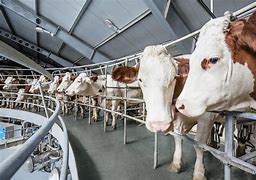World Bank Boosts Kyrgyzstan’s Agricultural Productivity and Climate Resilience – The Times Of Central Asia
World Bank Boosts Kyrgyzstan’s Agricultural Productivity and Climate Resilience Times of Central Asia

The World Bank Funds $30 Million Project to Enhance Productivity and Climate Resilience in Kyrgyzstan’s Agri-Food Clusters
The World Bank has announced funding of $30 million to help boost the productivity and climate resilience of Kyrgyzstan’s dairy and horticulture agri-food clusters.
Supporting Sustainable Development Goals
The project aligns with the Sustainable Development Goals (SDGs) set by the United Nations, particularly SDG 2: Zero Hunger, SDG 8: Decent Work and Economic Growth, and SDG 13: Climate Action.
Collaboration with Global Agriculture and Food Security Program
The project will be complemented by a $5 million grant from the Global Agriculture and Food Security Program.
Prioritizing Agriculture in Kyrgyz Republic
“Recognizing agriculture as a cornerstone of the Kyrgyz Republic’s economy, the World Bank prioritizes the sector alongside energy and water in its new 2024-2028 Country Partnership Framework. The new project marks the beginning of a series of initiatives designed to support the Cabinet of Ministers’ vision for a modernized, competitive, and climate-resilient agricultural sector,” reported Tatiana Proskuryakova, World Bank Regional Director for Central Asia.
Objectives and Duration
Running until 2029, the initiative aims to help producers, processors, and other value chain participants to improve the quality and volume of their produce. This will be achieved through various means, including investment loans, training and capacity building, seed system enhancement, breeding, and information management.
Focus on Climate Adaptation and Mitigation
The project will also focus on enhancing climate adaptation and mitigation through the promotion of climate-smart technologies. Additionally, digital technology will be employed to provide market information access.
Beneficiaries
The project will directly support 8,000 beneficiaries, including individual farmers and producers, producer groups, small and medium processors, and other value chain participants in the agri-food clusters of dairy and horticulture.
Furthermore, there will be indirect beneficiaries totaling 20,000. These will include farming communities and households of loan and training recipients, as well as members of broader rural communities who will benefit from improved job opportunities and income generation.
SDGs, Targets, and Indicators
1. Which SDGs are addressed or connected to the issues highlighted in the article?
- SDG 1: No Poverty
- SDG 2: Zero Hunger
- SDG 8: Decent Work and Economic Growth
- SDG 13: Climate Action
- SDG 15: Life on Land
2. What specific targets under those SDGs can be identified based on the article’s content?
- SDG 1.5: By 2030, build the resilience of the poor and those in vulnerable situations and reduce their exposure and vulnerability to climate-related extreme events and other economic, social, and environmental shocks and disasters.
- SDG 2.3: By 2030, double the agricultural productivity and incomes of small-scale food producers, in particular women, indigenous peoples, family farmers, pastoralists, and fishers, including through secure and equal access to land, other productive resources and inputs, knowledge, financial services, markets, and opportunities for value addition and non-farm employment.
- SDG 8.3: Promote development-oriented policies that support productive activities, decent job creation, entrepreneurship, creativity, and innovation, and encourage the formalization and growth of micro-, small-, and medium-sized enterprises, including through access to financial services.
- SDG 13.1: Strengthen resilience and adaptive capacity to climate-related hazards and natural disasters in all countries.
- SDG 15.1: By 2020, ensure the conservation, restoration, and sustainable use of terrestrial and inland freshwater ecosystems and their services, in particular forests, wetlands, mountains, and drylands, in line with obligations under international agreements.
3. Are there any indicators mentioned or implied in the article that can be used to measure progress towards the identified targets?
- Improved productivity and volume of produce
- Access to markets through investment loans
- Training and capacity building
- Enhancement of seed systems
- Promotion of climate-smart technologies
- Employment of digital technology for accessing market information
- Number of beneficiaries supported
- Number of farming communities and households benefiting from loans and training
- Creation of better jobs and income opportunities in rural communities
SDGs, Targets, and Indicators Table:
| SDGs | Targets | Indicators |
|---|---|---|
| SDG 1: No Poverty | SDG 1.5: Build resilience of the poor and vulnerable to climate-related events | – Number of beneficiaries supported – Creation of better jobs and income opportunities in rural communities |
| SDG 2: Zero Hunger | SDG 2.3: Double agricultural productivity and incomes of small-scale food producers | – Improved productivity and volume of produce – Access to markets through investment loans – Training and capacity building – Enhancement of seed systems |
| SDG 8: Decent Work and Economic Growth | SDG 8.3: Promote development-oriented policies that support job creation and entrepreneurship | – Number of beneficiaries supported – Creation of better jobs and income opportunities in rural communities |
| SDG 13: Climate Action | SDG 13.1: Strengthen resilience and adaptive capacity to climate-related hazards | – Promotion of climate-smart technologies – Employment of digital technology for accessing market information |
| SDG 15: Life on Land | SDG 15.1: Ensure conservation, restoration, and sustainable use of terrestrial ecosystems | – Number of beneficiaries supported – Creation of better jobs and income opportunities in rural communities |
Behold! This splendid article springs forth from the wellspring of knowledge, shaped by a wondrous proprietary AI technology that delved into a vast ocean of data, illuminating the path towards the Sustainable Development Goals. Remember that all rights are reserved by SDG Investors LLC, empowering us to champion progress together.
Source: timesca.com

Join us, as fellow seekers of change, on a transformative journey at https://sdgtalks.ai/welcome, where you can become a member and actively contribute to shaping a brighter future.







